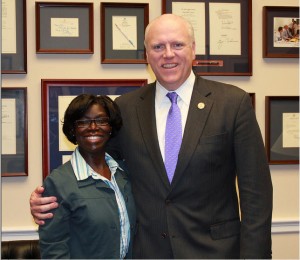This post comes from the Library of Congress Teacher in Residence, Earnestine Sweeting.
You can learn a lot by getting to know a member of Congress—either in person or through primary sources.
The United States Congress, the law-making body of the U.S., is made up of members who each represent the people of their district or state. The people can share their views with their Representative or Senator who, in turn, votes on proposed legislation in a way that best suits the needs of the people.
Representative Joseph Crowley proudly serves the 7th District in New York, my district. When I moved to Washington, D.C. to work as the Teacher in Residence at the Library of Congress, I couldn’t wait to request a meeting to share my news and express my views. Shortly after submitting my request, I heard from Rep. Crowley’s gracious staff, and the next thing I knew I was talking in person with the Congressman. Our conversation covered many topics, including Rep. Crowley’s passion for U.S. history, and it inspired me to think about ways to help students understand more about members of Congress and their work.
Teachers can introduce students to Congress, and to the way Congressional leaders have been depicted in the past, by analyzing a primary source. One Library of Congress primary source, “Our congressman” – past and present, is a “caricature showing congressman making a patriotic speech in the past in the past, and in the present as being bogged down with people lobbying for many different things.”
Teaching ideas:
- To support students’ understanding of perspective, teachers can ask part of the class to analyze the “past” and part of the class to analyze the “present” represented in the caricature. Each group can explain how images in the cartoon contribute to and clarify any character’s point of view.
- Teachers can further challenge students to brainstorm ideas about the tone, or the feeling the illustrator has intended for its viewers, and/or mood, the feeling the viewer receives.
- Since “the present” of this caricature represents the early 1900’s, ask your students to decide if anything would be different if it were drawn today.
To help older students understand historical and current legislation, take a look at Century of Lawmaking and THOMAS.
For more questions to guide students into analyzing cartoons, check out the Teacher’s Guide Analyzing Political Cartoons.
What questions do your students have about Congress?


